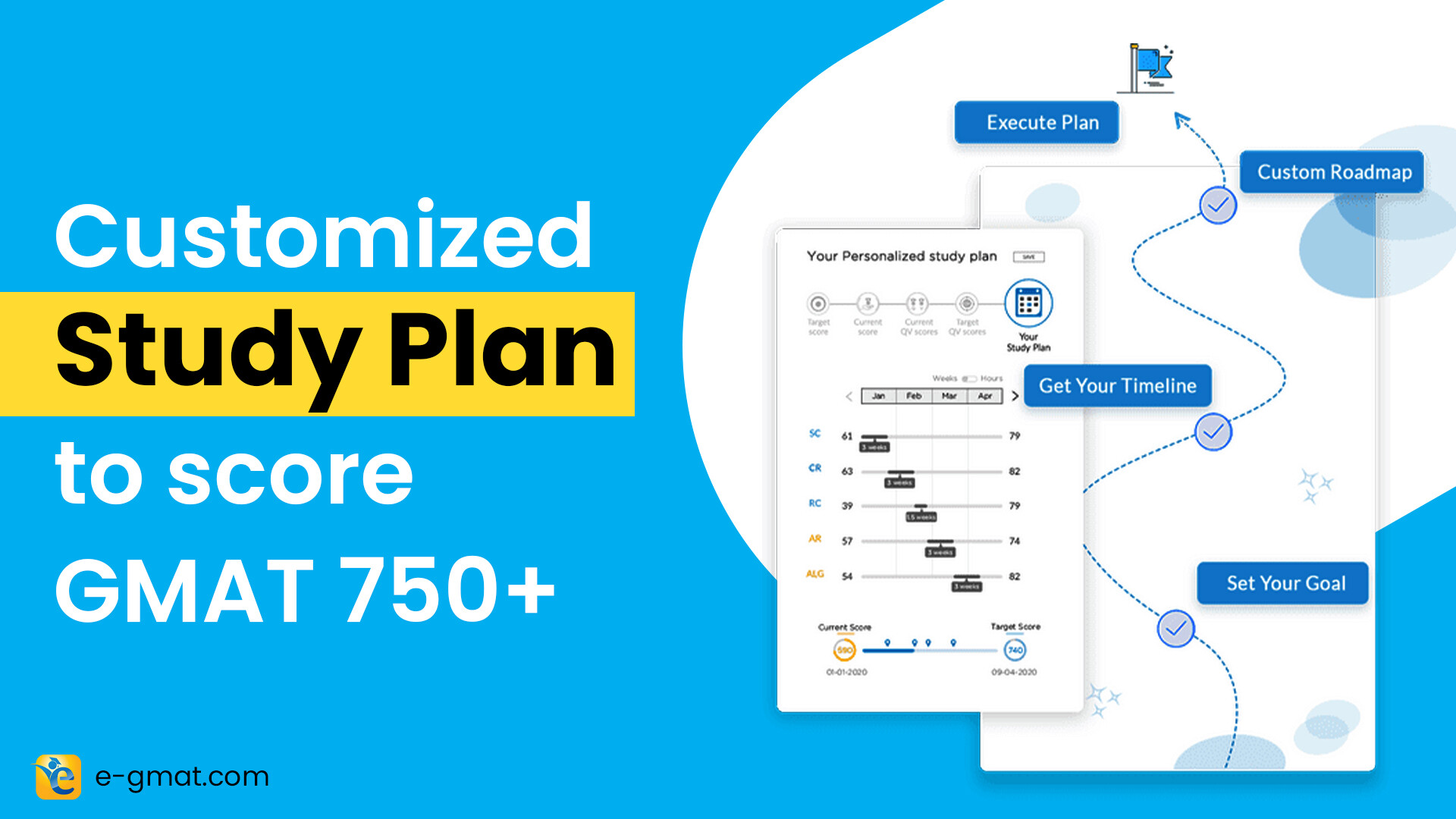GMAT Sentence Correction questions account for nearly 40% of the total questions asked in the GMAT verbal section. But if you are among the folks wondering how difficult is GMAT Sentence correction, you are not alone! GMAT SC is a tricky topic and takes time and effort to understand, but mastering it is the key to scoring a V40+ on GMAT Verbal. However, understanding it can be made easy through a meaning-based approach.

So, you have decided to take some time out and decode the enigma called GMAT Sentence Correction, welcome! In this article, we shall cover all the basics of sentence correction for GMAT.
At its core, GMAT Sentence Correction (GMAT SC) requires you to put on your “detective hat”. Just as detectives solve their cases by making intricate logical connections between different pieces of evidence, visualizing the crime, and using their subject matter knowledge, so do test takers an Sentence correction question by making logical connections between different parts of a sentence, visualizing the meaning, and using their knowledge of standard English.

If you are planning to take the GMAT, we can help you with a personalized study plan and give you access to quality online content to prepare. Write to us at acethegmat@e-gmat.com. We are the most reviewed GMAT prep company on gmatclub with more than 2500 reviews.
Why don’t you take a free trial and judge it for yourself?
As per the Official Guide, the GMAT SC tests our language proficiency in the following ways:
- Correct expression: A correct sentence needs to be grammatically and structurally sound.
- Effective expression: An effective sentence expresses an idea or a relationship clearly and concisely.
- Proper diction: An effective sentence also has the right choice and use of words.
What’s more? GMAT SC accounts for almost one-third of your verbal score. So, if you have that target score of 700+, you can do anything but take this sub-section lightly!
Intrigued much? This is just the beginning. Read on as we decipher what the GMAT SC is all about. In this article, we shall discuss some of the basic questions related to Sentence correction in GMAT- what it really is, what it tests and what it doesn’t, and why does it test what it tests.
OUTLINE OF THE ARTICLE:
- 1. Will reading this article make a difference?
- 2. Structure of a GMAT Sentence Correction Question
- 3. Types of errors in GMAT Sentence Correction Questions
- 4. What does the Sentence Correction in GMAT not test?
- 5. Why the GMAT tests Sentence Correction
- 6. Conclusion:
- 7. 25 GMAT Sentence Correction Practice Questions
- FAQs – GMAT Sentence Correction questions
1. Will reading this article make a difference? | GMAT Sentence Correction
Why should you trust us or anything we say? Well, for the simple reason that we have delivered more success than any of our competitors. We have 2600+ reviews on the GMAT club, which is a well-known online community for GMAT aspirants. That puts us leaps and bounds ahead of our closest competitor, who has only 600 5-star reviews on the GMAT Club. We also have the highest number of success story interviews on YouTube. This bears witness to the fact that our methods have indeed come a long way in helping our students achieve a high GMAT score.
Our flagship GMAT SC course has helped students hit their target scores, no matter what their starting ability was. For example, Ram got a 730 on the GMAT in his very first attempt and aced the SC section by using the meaning-based approach. Aayush was able to score a whopping 750 in his 3rd attempt by using a structured approach to solving SC questions, rather than relying on his ‘ear and gut instincts’ as he did in his first two attempts, before going through the e-GMAT course.
Our students vouch for our unique Meaning-based Approach to Sentence Correction! Hear from our students Pooja, Aayush, and Vaik how it helped them ace SC. What is even more interesting is how this approach works wonders for non-native speakers. Rohan overcame his weakness in English by learning and applying the e-GMAT approach and scored a 750!

2. Structure of a GMAT Sentence Correction Question
Let us start with the most basic of basic questions. What does a GMAT Sentence Correction question look like?
Here is a sample of an SC question from the Official guide:

Every SC question consists of two components: A sentence, part or all of which is underlined and five answer choices, each a way of phrasing the underlined portion.
The underlined portion of the sentence may contain grammatical and logical errors, which we will discuss in section 3. Answer choice A repeats the original underlined portion. The other four answer choices are each a different phrasing of the original underlined portion.
Your job is pretty simple: pick the alternative that best expresses the author’s intent and that is clear, exact, and free of errors. It must also minimize awkwardness, ambiguity, and redundancy. Select answer choice A if the original sentence is correct as is. If not, select the most pertinent answer choice among B, C, D, and E. Remember, there is only one correct choice for each question.
700 scorer’s strategy: Though you must rectify only the underlined portion of the sentence, do not forget about the non-underlined portion! Ensure that you pay close attention to how the underlined portion connects to the other parts of the sentence.
Bonus: Do not read option A while going through the answer choices as you have already read the underlined portion of the original sentence. This will save you quite a bit of time in the test environment.
Before you proceed further, here is a quick quiz to determine your current SC abilities and get a feel of the official SC questions tested on the GMAT SC. Try your hand at the same:
At this point, if you are itching to try your hand at a few fascinating SC questions, we have got you covered! Our free trial contains a good collection of SC questions for your practice.
3. Types of errors in GMAT Sentence Correction Questions
As explained in the previous section, every GMAT SC question tests your ability to evaluate a given sentence for any grammatical and meaning errors and to resolve them, if any.
The practice of assigning each error you encounter in GMAT SC to a specific type during your preparation helps you big time in identifying errors quickly when the clock is ticking against you during the exam.

We at e-GMAT have done our homework and have simplified and compartmentalized the various errors you encounter in GMAT SC so that you don’t have to lose sleep over it.
Fun fact: Most sentences in SC have 2-3 different types of errors in them. You will occasionally find a sentence which has no error in it, but in such situations the answer choices introduce 2 to 3 errors of their own. There are very few SC questions that have only one error in them.
GMAT Sentence Correction – Error types:
- Subject-Verb Error
- Verb tense error
- Pronoun- antecedent agreement error
- Modifier error
- Parallelism error
- Comparison error
- Idiomatic error
- Meaning error
- Other errors
Let’s talk about each of them in detail:
3.1 Subject-Verb Error
Before we get into the errors pertaining to subjects and verbs, let us first understand what a subject and a verb is. Consider this sentence:
- Jack runs on the beach.
The above sentence is about “Jack.” Therefore, he is the main topic of the sentence and the doer of the action that follows. He is the “subject” of the sentence.
The action that the subject Jack does is “runs.” Therefore, “runs” is the verb in this sentence.
There can be multiple subjects and multiple verbs in a sentence. The important point to note is that we must associate every subject with a verb and vice versa. Otherwise, the sentence won’t make sense. Also, a singular subject must be associated with a singular verb, and a plural subject must be associated with a plural verb.
Now that we are clear about what the subjects and the verbs are, let us jump right into the errors related to Subjects and Verbs:
Subject-verb must make sense:
Consider this sentence:
- The manufacturer guarantees that the silky red dress with a silver buckle will not corrode.
Something seems off in the above sentence. The author intends to say that the silver buckle will not corrode, but the way the sentence is written, it conveys the meaning that the silky red dress will not corrode, This does not make sense because a dress cannot corrode! We can correct this sentence by rewording it as follows:
The manufacturer guarantees that the silver buckle on the silky red dress will not corrode.
Subject-Verb must agree in number:
Now consider this sentence:
- The current costs has created a good opportunity.
Again, the above sentence is incorrect. The subject of the sentence, the plural noun “costs”, uses a singular verb or action “has created.” Therefore, the subject and the verb do not agree in number.
So, there you go: the subject and the verb must make sense, and they must agree in number. Any sentence in the SC section that violates these conventions will fall under the category of Subject Verb error.
700 scorer’s strategy: The subjects and verbs are the backbones upon which the entire sentence relies. If you are just starting out with your SC journey, we strongly suggest that you first master the skill of identifying subjects and their corresponding verbs. Doing so will take you a long way in your SC journey.
3.2 Verb Tense Error in GMAT Sentence Correction Questions
This type of error has got everything to do with the three main time frames in the English language: the past, the present and the future, and their sub –tenses a.k.a. “aspects”. Simple right?
Now mix these tenses up in a sentence and add a pinch of Conditionals and top the whole thing up with a bit of Subjunctives, and you have got yourself a sentence horrifying enough to keep you awake at night, right?

Well, not quite. That would happen only if you do not get the basics right. So, let’s start with that.
The underlying principle behind identifying any verb-tense error is to be crystal clear about the time frame in which each and every event in the sentence occurs. This is where you should put on your logical thinking hats.
Let us see this in action with a simple example:
- Amy had gone to sleep when the phone rang.
This sentence conveys the meaning that by the time the phone rang, Amy had already gone to sleep.
Now consider this slight tweak in the sentence:
- Amy went to sleep when the phone rang.
This sentence coveys the meaning that Amy went to slept at the exact time the phone rang.
Notice how a change in the time frame of Amy’s sleeping changes the entire meaning of the sentence. Identifying this difference is critical while solving SC questions.
Now let us crank it up a notch and bring in the concept of conditionals. A conditional sentence takes application of tenses to a whole different level. It introduces us to the world of real and unreal ideas through various constructions, such as if-then, would, etc. For example:
A. If I went to work, I took my phone with me.
B. If I went to work, I wouldn’t have an office at home.
Sentence A conveys a past truth, whereas sentence B conveys a hypothetical idea in the present. The first tells us something I always did whenever I went to work. But the second implies that I don’t go to work. That’s why I have an office at home. If I went to work, I wouldn’t have an office at home.
Next, we have the moods of verbs, a less-known concept of grammar. Moods of verbs indicate how the overall sentence is viewed or perceived. GMAT SC’s favourite mood is the Subjunctive, the mood that is used to convey hypothetical ideas. A common usage of the subjunctive is in sentences that convey suggestions, recommendations, or advice against things being practised. For example,
- The Supreme Court ordered that sale and consumption of alcohol be banned across the country.
Notice how the sentence above uses the subjunctive form ‘be’ and not ‘is’ or even ‘should be’ to convey something that should be brought into practice throughout the country.
We have just scratched the surface here! Obviously, there are different levels to any skill. No matter whether you are dealing with conditionals, subjunctives, or plain and simple tenses, if you want to do well in GMAT SC, you must be able to identify the time frame of every event and the impact of change in tense on the meaning of the sentence.
700 scorer’s strategy: Ensure that you cover the three main tenses in the English language along with the concepts of conditional constructions and subjunctives to master the verb tense errors on the GMAT.
3.3 Pronoun-Antecedent Agreement Error
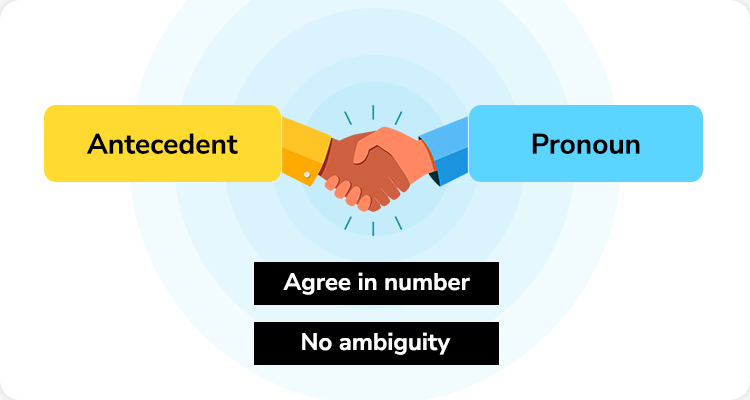
Looking for a good GMAT course for SC preparation? Start your GMAT Preparation with the most reviewed online GMAT prep company. Try out our FREE Trial Today!
A pronoun, which acts as a substitute for another noun entity in the sentence, must agree with that noun entity (also called the antecedent of the pronoun): it must have the same number, be of the same gender and person, and match the role it plays in the sentence. For example, consider this sentence from the Official guide:
- John loves exercising, so they go to the gym daily.
In the above sentence, the plural pronoun “they” refers to the singular noun “John”. Therefore, there is a pronoun-antecedent number agreement error. We must use the singular pronoun “he” so that the pronoun agrees with the noun “John” in gender, number, person, and function.
Additionally, there should be no scope for ambiguity with regards to the antecedent of a pronoun. A pronoun must clearly and unambiguously refer to its antecedent. For example, consider this Official sentence:
- The Eastern State Penitentiary was established in 1822 by reformers advocating that prisoners be held in solitary confinement and hard labor so as to reform them.
Here, the reference of the pronoun “them” is ambiguous. It could refer to “reformers,” “prisoners,” or even “solitary confinement and hard labor!” We can correct the sentence as follows:
The Eastern State Penitentiary was established in 1822 by reformers advocating solitary confinement and hard labor as the means to reform prisoners.
700 scorer’s strategy: It is not necessary that an antecedent always appear before a pronoun. The antecedent of a pronoun can appear much later in the sentence. For example:
- Although it is a big firm, ABC Corporation rarely recruits from top colleges.
Here, the pronoun “it” appears before the antecedent “ABC Corporation.”
3.4 Modifier Error in GMAT SC
The Modifier Error is the king of all the error types tested in GMAT SC!
Most students dread this error type, but there is no escape from it because it is also one of the most frequently tested error types in GMAT SC.
A Modifier is a word or a group of words that gives additional information about another word, group of words, or a sentence. More often than not, the errors belonging to this category are “misplaced modifier” errors. What this means is that the modifier is placed incorrectly in the sentence such that it doesn’t modify the intended entity. All you must do is move the modifier to the correct position et voila! you have corrected the modifier error (along with a bit of other possible minor tinkering of course!)
Here is a demonstration of how to correct the misplaced modifier error in the given Official GMAT SC question:
- Studying skeletons unearthed near Rome, DNA evidence was recovered by scientists, who were able to deduce from this that an epidemic of malaria struck in the empire’s waning days.
In this sentence, the modifier “studying skeletons near Rome” incorrectly modifies “DNA evidence.” How can DNA evidence study the skeletons? Logically, the given modifier must modify “scientists.” This error can be corrected as follows:
Scientists studying skeletons unearthed near Rome recovered DNA evidence from which they were able to deduce that an epidemic of malaria struck in the empire’s waning days.

Another modifier error tested in SC is the dangling modifier error. This error is exactly what the word “dangling” means. The modifier just dangles in the sentence without referring to anything in the sentence. Consider this official question for example:
- Without adequate amounts of sleep, people’s newly acquired skills and also new factual information may not get properly encoded into their memory circuits.
The modifier “without adequate amounts of sleep” does not point to anything in this sentence. Logically, it must modify “people”, but the word “people” is not present in the sentence. All we have in the sentence is “people’s skills”. Therefore, the given modifier is dangling. We can correct this error as follows:
If people do not get adequate amounts of sleep, newly acquired skills and even new factual information may not get properly encoded into their memory circuits.
Point to note: Modifiers is a vast topic on the GMAT SC, and you might get confused what to study and what not to study. To make your life easier, here is a list of the type of modifiers you should definitely cover:
- Adjectives,
- Adverbs,
- verb-ing modifiers (modifying nouns and actions),
- verb-ed modifiers (modifying nouns and actions),
- relative pronoun modifiers, and
- noun+noun modifiers.
3.5 Parallelism Error
The entities that perform the same function in a sentence must be parallel. Entities in a list are, hence, parallel entities. A sentence often contains a list of various elements such as words, phrases, or clauses. These elements must be consistent or “parallel” with one another in terms of logic and grammar. That is what the concept of parallelism entails. The test makers introduce parallelism errors in the sentence by making one or more elements of the list inconsistent in terms of logic and grammar.
Here is a small exercise for you. Solve this question from the Official guide that tests parallelism:

Try out our Free Trial today and get access to 10+ hours of free interactive video lessons, 400+ GMAT-like questions, and AI-drive tools that help you track your progress. We are the most reviewed GMAT Preparation company on the GMAT Club, with 2500 reviews!
The correct answer for this question is option B. Kudos to you if you got it right! But do not fret if you did not. This is just the beginning of your SC journey. Let us see how to go about solving this question.
The meaning of the sentence is quite clear: travellers from Earth to Mars would have to do four different things. However, the two of the actions mentioned (avoid large doses of radiation and contend with chemically reactive Martian soil) are not consistent with the other two in the original sentence. Therefore, the sentence has a parallelism error. We can correct this error by making all the four entities parallel as done in the correct answer choice B.
700 scorer’s strategy: Watch out for words such as and, either/or, not only/but also, but, etc. They indicate the presence of parallelism
3.6 Comparison Error in GMAT Sentence Correction
A sentence may contain a comparison or contrast between two or more elements. Comparison, in a way, is also a test of parallelism because the elements being compared must be grammatically and logically parallel to one another. For starters, the test makers introduce comparison errors by making an illogical comparison. The popular saying “apples and oranges” applies perfectly here.

Here is a classic official example of the same:
- Unlike the virginal, whose single set of strings runs parallel to the front edge of the instrument, the harpsichord’s several sets of strings are placed at right angles to its front edge.
Even though the sentence intends to present contrast between the two instruments, virginal and harpsichord, the sentence is written in such a way that it presents an illogical comparison between the virginal and the sets of strings of the harpsichord. We can correct this sentence by presenting a contrast between the two instruments as follows:
- Unlike the virginal, which has a single set of strings that run parallel to the front edge of the instrument, the harpsichord has several sets of strings placed at right angles to its front edge.
Moving further, the test makers could even present you with a case of ambiguous comparison. For instance,
- Joe likes the pizza more than John.
The above sentence is ambiguous: Does Joe like the pizza more than he likes John? Or does Joe like the pizza more than John likes the pizza?
We can eliminate the ambiguity by re-phrasing the sentence in the following ways:
- Joe likes the pizza more than John does.
- Joe likes the pizza more than he likes John.
Bingo! We have corrected the comparison error! Both the sentences above present valid comparisons respectively, even though the first is more likely the intended meaning. Under normal circumstances and unless specified explicitly, a person wouldn’t like a pizza more than another person. The GMAT expects you to bring this understanding to the table.
700 scorer’s strategy: Be on the lookout for words such as like, as, than, compared to, different from, etc. They indicate the presence of comparison in a sentence.
3.7 Idiomatic Error
Here is a small exercise for you:
Identify the sentences that are incorrect:

Only sentence 2 above is correct. Both sentences 1 and 3 are wrong. It is incorrect to say “so much fun as” in sentence 1. The correct expression is “as much fun as.” Similarly, it is incorrect to say “At average” in sentence 3. The correct expression is “On average.”
But this is where it gets interesting: Can you think of any earthly reason why the expressions written in boldface in sentences 1 and 3 are wrong?
I bet my bottom dollar that you cannot! That is because this is simply how we do things in English.
Such expressions, which consist of ordinary words but whose meaning cannot be inferred from the meanings of their component parts, are called idioms.
To communicate effectively in English, it is important to be aware of these standard expressions. Therefore, such expressions are extensively tested on the GMAT SC. The test makers introduce an idiomatic error by replacing one of the component words – usually a preposition – of standard expressions with an incorrect one; and you are often expected to identify such errors in answer choices that are otherwise free of grammatical errors, making such questions even more difficult to solve.
700 scorer’s strategy: The idioms in the English language are so numerous that it is impossible to list them all. So don’t even try! The best way to learn idioms is by reading and practicing.That being said, ensure that you cover the frequently tested idioms on the GMAT during your preparation. These include:
Idioms related to as, so, and, or/nor, not
Idioms related to quantities
Usage of due to vs because of
Idioms of comparison
3.8 Meaning Error in GMAT SC
A perfect sentence is one that communicates a clear meaning in the most succinct and direct way and is clear of any grammatical errors.
Meaning errors are introduced in a sentence by using wrong words, making the sentence awkward, or presenting an ambiguous meaning.
The right usage of words, or Diction, is very important to communicate the right meaning. Diction errors are introduced in a sentence by using the incorrect part of speech, the wrong quantifying words, incorrect prepositions, etc. For example, consider these two sentences:
- Currently, builders do not have many incentive to build huge mansions.
- I was ease able to figure out the solution to the given problem.
Both the above sentences are incorrect. In the first sentence, the uncountable noun ‘incentive’ has been modified by ‘many’ instead of ‘much’, whereas in the second sentence, the verb ‘was able’ has been modified by the adjective ‘ease’ instead of the adverb ‘easily’.
Rhetoric is the art of using language in speech or writing in a special way that facilitates comprehension and even influences people. When the GMAT says that it tests us on Rhetorical Construction, it refers to eloquence. A sentence could be grammatically, idiomatically, and even logically sound, but still be vague and awkward. Take a look at the following examples taken from the Official Guide:
- Expectedly, the goodness of her doing the job was considerable.
- Her hope was for other solar systems’ planets’ possible human exploration.
The above sentences are technically correct, but they’re immensely confusing. This is how we put them rhetorically, respectively:
- As expected, she did the job very well.
- She hoped that humans would be able to explore some of the planets in other solar systems.
Finally, in GMAT SC, you will sometimes find a sentence whose meaning is ambiguous. The best way to go about this type of error is to infer all the possible logical meanings from the context and select the option that conveys one of the possible meanings clearly and unambiguously.
700 scorer’s strategy: Some people fall into the trap that a shorter answer choice is a safer bet than a longer choice. Such guesses can be dangerous and unwarranted. Always eliminate an answer choice for the right reasons.
3.9 Other Errors – GMAT SC questions
We have covered the majority of the errors that you would encounter in SC in the above nine categories. However, there are few additional types of errors you must be aware of, such as sentence fragments, punctuation and linkage errors, and run on sentences.
Sentence fragments, as the term indicates, are parts of a sentence that do not function as intended because of a missing verb or a missing subject. Consider this official sentence for example:
- The foundation works to strengthen local and regional agricultural markets and cooperating with governments to improve access for farmers to productive resources such as land and credit.
The intended meaning of the sentence is that the foundation does two things: works to strengthen markets and cooperates with the governments. However, the portion in the boldface is a sentence fragment and has a missing verb. We can correct this error by converting the word “cooperating” to the verb “cooperates”.
Punctuation and linkage errors occur when the elements present in a list are not connected properly or when the different parts of a sentence are connected incorrectly. For example, here’s an official sentence with a punctuation error in it. Can you spot it?
- As a baby emerges from the darkness of the womb, its rudimentary sense of vision would be rated about 20/500; qualifying it to be legally blind if an adult.
This is a classic case of the incorrect use of a semi-colon! We need to use a comma instead of a semicolon in the above sentence.
A run on sentence occurs when two complete sentences (A complete sentence is the one which has at least one subject-verb pair) are connected without proper punctuation or connecting words. For example:
- The task was challenging, the reward was worth it.
Two sentences are improperly connected using just a comma. To connect the two sentences, we must use a proper connecting word such as “but” along with the comma.
Here is a quick summary of all the errors for your reference:
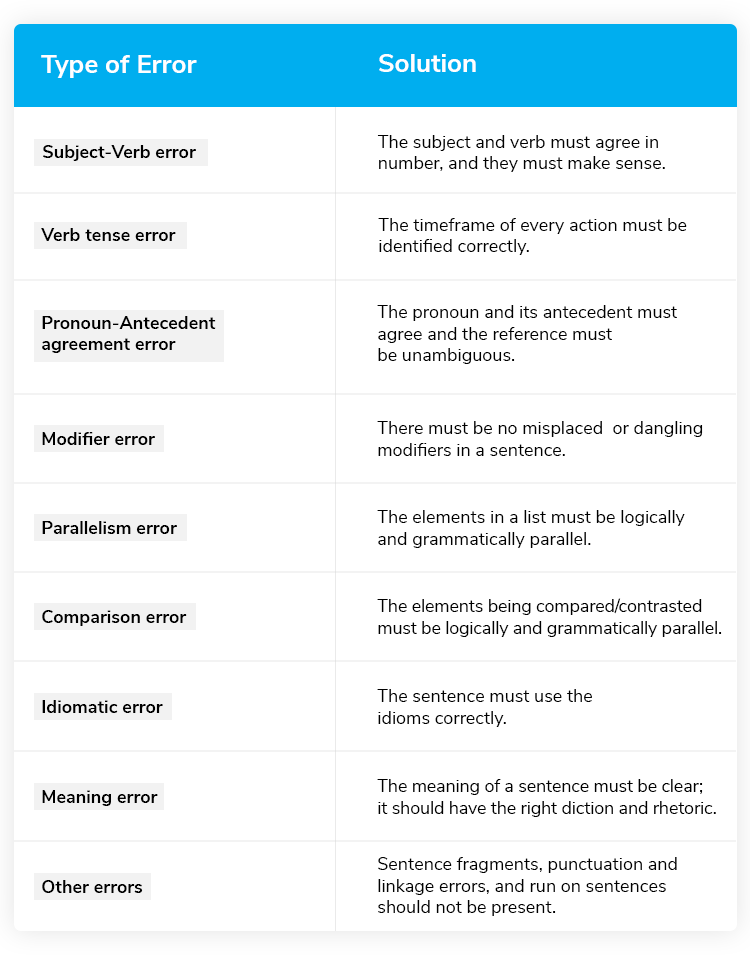
So, there you go! The above are all the different error types that you will encounter in GMAT SC. We at e-GMAT have designed our course modules in such a way that we systematically teach the concepts related to each error type, one module after the other in the same order as explained above. You can check this out in our free trial!

4. What does the Sentence Correction in GMAT not test?
The English language is very vast, and it gets even more complicated when we add the nuances of local variations in the language and ever-evolving technical jargon. It is impossible to learn anything and everything under the sun! Thankfully, the GMAT has set boundaries, within which it tests one’s ability. As per the Official guide, here are the things that are NOT tested on GMAT SC, :
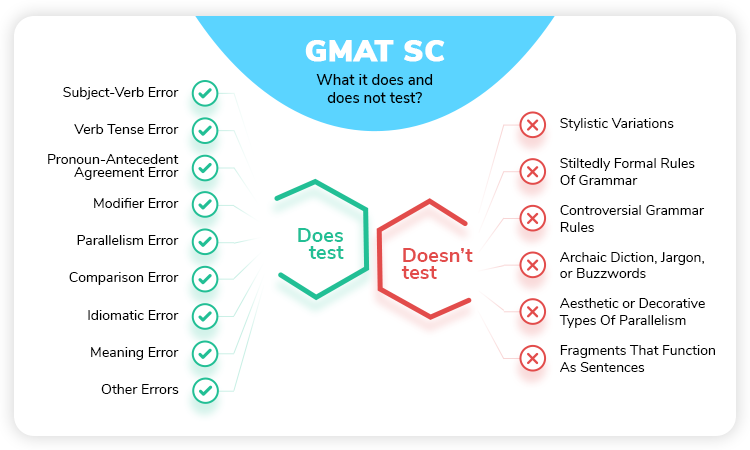
4.1 Stylistic Variations
You are not expected to choose between different forms of words that have the same function and meaning. For example: While/Whilst, until/till etc. You are also not expected to judge conventions of punctuation that vary from region to region or are matters of pure style. For example, according to the OG, you will not be asked to judge whether a comma should be placed inside or outside a closing quotation mark, whether emphasis should be indicated by italics or whether an apostrophe should be inserted before the “s” in a non-plural word (ABCs vs. ABC’s).
4.2 Stiltedly Formal Rules Of Grammar
Some people advise the usage of subject pronouns (I, you, she, he, we etc.) in both the subject and object case with the verb “to be.” For instance, It is I who laughed.
It is me who laughed. According to this rule, the 1st sentence is correct, and the 2nd is incorrect. GMAT SC stays away from such stiltedly formal rules of grammar. You are not expected to eliminate any answer choice based on the above reason.
4.3 Controversial Grammar Rules
GMAT SC stays away from controversial grammatical rules such as usage of which vs that in restrictive contexts (Restrictive contexts in very simple terms, are when commas do NOT appear before the that/which modifiers). As far as the GMAT is concerned, both the below sentences given in the Official guide are correct:
- Laws which have been repealed are no longer enforced.
- Laws that have been repealed are no longer enforced.
Another example is of the split infinitive. Infinitives, or to-verb phrases, are phrases beginning with ‘to’ followed by a verb in its first form. For example: to eat, to sleep, etc. Some people object to placing an adverb between “to” and ‘the verb’. For example:
- To finally bake the cake.
Here, finally is placed inside the to-verb phrase “to bake.”
You should not expect to see SC questions for which the deciding factor is whether the writer adheres to the above objection.
4.4 Archaic Diction, Jargon, or Buzzwords
Archaic words such as “thou,” “shalt,” “maketh” sound great in a Shakespearean play, but you are not expected to correct such words or understand that they can be paraphrased as something else. For example, as given in the Official guide, you are not expected to know that “skint” can be paraphrased as “lacking resources.”
Additionally, you are not expected to know highly specialized technical jargon, buzzwords, and obsolete forms of idiomatic expression. You will also not be expected to know whether a highly specialised term, say FMCG (Fast moving consumer goods), takes a plural or a singular verb.
4.5 Aesthetic or Decorative Types Of Parallelism
As per the Official guide, “SC questions do not require decisions about aesthetic or decorative types of parallelism. For example, you will not be asked to decide whether a rhymed pair such as “highways and byways” would be preferable to another phrase that is equivalent in meaning and function.”
4.6 Fragments That Function As Sentences
As far as the GMAT is concerned, a group of words must have a subject and a verb to function as a sentence. However, in colloquial English, a group of words that has no subject or a verb sometimes functions as a complete sentence. For example, “No,” “the one on the right,” or exclamations such as “how sweet!” You should not expect to see a GMAT SC question in which the above function as complete sentences.
5. Why the GMAT tests Sentence Correction
Now that we know all about what are tested and are not tested on GMAT SC, let us decode why this section exists in the Verbal Reasoning section in the first place, and why should you give it importance?
How we wish Homo-Sapiens had the superpower of telepathy so no ideas would ever get misinterpreted and no scope for a gap in communication would ever exist. However, in the absence of this fantastical ability, the next best tool at our disposal is language, in particular, the standard written English language. The correct usage of this tool, i.e. to avoid any misquotes and misinterpretations, and the effective usage of this tool, i.e. to express ideas in the best possible manner, are of utmost importance. And that is exactly what the GMAT SC tests.
The correct and effective usage of the English language or any language for that matter requires the awareness of the logical implications of the grammatical forms and elements. Let us see the same in action:
Suppose a person A makes the following statement:
- Flying planes can be dangerous.
This sentence is flawed because it can be interpreted in two different ways:
Person X interprets it as: Planes that are in the air can be dangerous.
Person Y interprets it as: To fly planes can be dangerous
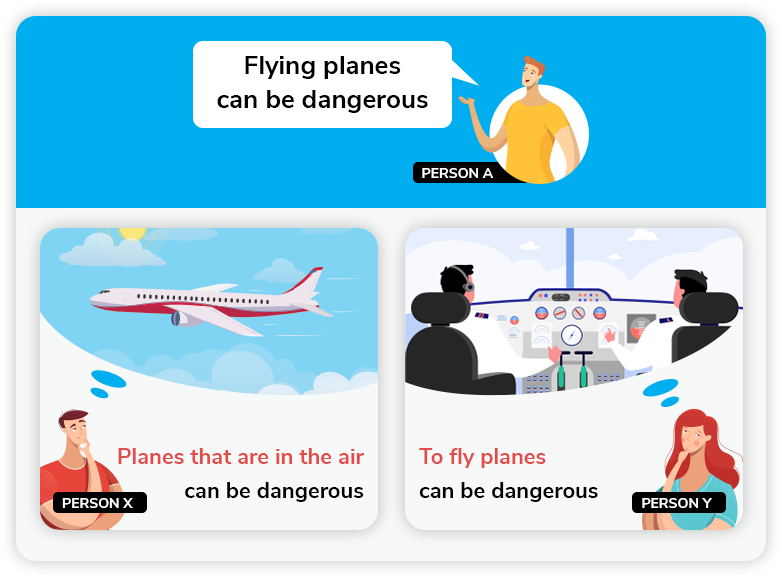
Now imagine that person A uses similar language to communicate something important, and persons X and Y take different courses of actions based on their different interpretations! The cost of such ineffective communication would be huge.
This is true, especially in government, commerce, education, or any other sector that an aspiring manager aims to get into. Therefore, the GMAT has a good reason to test these skills of prospective managers.
At the same time, it is important to note that grammar is important insofar that it is required to communicate the correct meaning. Beyond that, the GMAT does not want you to be a grammarian!
6. Conclusion:
This brings us to the end of this article. Congratulations on taking the first step towards your GMAT Sentence Correction journey! We hope you now have a good idea about what Sentence correction in GMAT really is, what an SC question looks like, what SC tests, and what it doesn’t.
But this is not all there is to Sentence Correction in GMAT. If you want to learn how to ace GMAT SC and what core skills to build to do so, then watch out for our follow up article. In that article, we will cover the 4 core skills required to ace the GMAT SC:
- Understand the sentence structure
- Understand the intended meaning
- Error analysis
- Answer choice analysis
Additionally, if you are someone who has just begun your preparation or you have been preparing for some time but aren’t able to get past the 90th percentile threshold, then watch out for our article on how to study to score 90th percentile on SC. We will cover the best practices and the tools one requires to ace this section. We will also cover what not to do in your SC preparation journey to safeguard yourself from the common pitfalls.
So what are you waiting for? Begin your GMAT preparation today!

To help you kickstart your GMAT SC preparation, in this article, we have shared the top 25 most searched GMAT Sentence Correction questions and their solutions.
Take a look at these questions and try to answer them. Once you arrive at an answer, take a look at the solution and analyze the following 2 aspects:
- If you answered correctly, did you follow the correct approach?
- If you answered incorrectly, where did you go wrong?
25 GMAT Sentence Correction Questions:
- Question 1 – Heavy commitment | OG16 SC 110
- Question 2 – Halley’s comet | OG21 SC 997
- Question 3 – Neanderthals appear | SC07231
- Question 4- Emily Dickinson
- Question 5- 32 species that make up | OG – PQID : SC03207
- Question 6- Ridley turtle
- Question 7- Association of American Medical College
- Question 8- Starfish
- Question 9- Marconi’s conception of the radio
- Question 10- Global economy grew
- Question 11- Out of America’s fascinaton
- Question 12- When a hagfish is threatened | OG21 SC 867
- Question 13- Sickle cell anemia
- Question 14- Percentage of the labor force
- Question 15- The commission acknowledged
- Question 16- Ancient Egyptian monuments
- Question 17- Surviving a takeover offer
- Question 18- Rogers Pass in Glacier National Park
- Question 19- Weakness of the hypothesis | SC81561.01
- Question 20- An archeological excavation | SC24561.01
- Question 21- Railroad employees | SC01561.01
- Question 22- During an ice age | SC30561.01
- Question 23- The prime lending rate | SC21011.01
- Question 24- Lacking information | SC83811.01
- Question 25- Ball courts in Mesoamerica
Question 1
Heavy commitment by an executive to a course of action, especially if it has worked well in the past, makes it likely to miss signs of incipient trouble or misinterpret them when they do appear
[Refer to GMAT OG for options]
OG16 SC110
Have you attempted question 1?
Take a look at the correct answer
Question 2
In no other historical sighting did Halley’s comet cause such a worldwide sensation as did its return in 1910-1911
[Refer to GMAT OG for options]
Have you attempted question 2?
Take a look at the correct answer
Question 3
Combining enormous physical strength with higher intelligence, the Neanderthals appear as equipped for facing any obstacle the environment could put in their path, but their relatively sudden disappearance during the paleolithic era indicates that an inability to adapt to some environmental change led to their extinction.
[Refer to GMAT OG for options]
Have you attempted question 3?
Take a look at the correct answer
Question 4
Emily Dickinson’s letters to Susan Huntington Dickinson were written over a period beginning a few years before Susan’s marriage to Emily’s brother and ending shortly before Emily’s death in 1886, outnumbering her letters to anyone else.
[Refer to GMAT OG for options]
Have you attempted question 4?
Take a look at the correct answer
Question 5
The 32 species that make up the dolphin family are closely related to whales and in fact include the animal known as the killer whale, which can grow to be 30 feet long and is famous for its aggressive hunting pods.
[Refer to GMAT OG for options]
Have you attempted question 5?
Take a look at the correct answer
You can get access to more Sentence Correction questions and solutions for free here.
We can help you with a personalized study plan and give you access to quality online content on Quant and Verbal to prepare.
Write to us at acethegmat@e-gmat.com if you have any queries. We are the most reviewed GMAT prep company on gmatclub with more than 2060 reviews.
Question 6
Last week local shrimpers held a news conference to take some credit for the resurgence of the rare Kemp’s ridley turtle, saying that their compliance with laws requiring that turtle-excluder devices be on shrimp nets protect adult sea turtles.
[Refer to GMAT OG for options]
Have you attempted question 6?
Take a look at the correct answer
Question 7
According to a survey of graduating medical students conducted by Association of American Medical College, minority graduates are nearly four times more likely than are other graduates in planning to practice in socioeconomically deprived areas.
[Refer to GMAT OG for options]
Have you attempted question 7?
Take a look at the correct answer
Question 8
Starfish, with anywhere from five to eight arms, have a strong regenerative ability, and if one arm is lost it quickly replaces it, sometimes by the animal overcompensating and growing an extra one or two.
[Refer to GMAT OG for options]
Have you attempted question 8?
Take a look at the correct answer
Question 9
Marconi’s conception of the radio was as a substitute for the telephone, a tool for private conversation; instead, it is precisely the opposite, a tool for communicating with a large, public audience.
[Refer to GMAT OG for options]
Have you attempted question 9?
Take a look at the correct answer
Question 10
Between 1990 and 2000 the global economy grew more than it did during the 10,000 years from the beginning of agriculture to 1950.
[Refer to GMAT OG for options]
Have you attempted question 10?
Take a look at the correct answer
Question 11
Out of America’s fascination with all things antique have grown a market for bygone styles of furniture and fixtures that are bringing back the chaise lounge, the overstuffed sofa, and the claw-footed bathtub.
[Refer to GMAT OG for options]
Have you attempted question 11?
Take a look at the correct answer
Question 12
Although when a hagfish is threatened, it will secrete slime that is small in quantity, it expands several hundred times as it absorbs seawater, forming a slime ball that can coat the gills of predatory fish and either suffocate them or distress them enough to make them flee.
[Refer to GMAT OG for options]
Have you attempted question 12?
Take a look at the correct answer
Question 13
People who inherit the sickle cell anemia gene from only one parent seem to be resistant to malaria, an evolutionary advantage that may explain why a genetic condition so debilitating to many individuals has survived in the human population.
[Refer to GMAT OG for options]
Have you attempted question 13?
Take a look at the correct answer
Question 14
The percentage of the labor force that is unemployed has dropped sharply this month, even though it may be only temporarily.
[Refer to GMAT OG for options]
Have you attempted question 14?
Take a look at the correct answer
Question 15
The commission acknowledged that no amount of money or staff members can ensure the safety of people who live in the vicinity of a nuclear plant, but it approved the installation because it believed that all reasonable precautions have been taken.
[Refer to GMAT OG for options]
Have you attempted question 15?
Take a look at the correct answer
Question 16
To help preserve ancient Egyptian monuments threatened by high water tables, a Swedish engineering firm has proposed installing pumps, perhaps solar powered, to lower the underground water level and dig trenches around the base of the stone walls.
[Refer to the GMAT Official Guide for options]
Have you attempted question 16?
Take a look at the correct answer
Question 17
The odds are about 4 to 1 against surviving a takeover offer, and many business consultants therefore advise that a company’s first line of defense in eluding offers like these be to even refuse to take calls from likely corporate raiders.
[Refer to the GMAT Official Guide for options]
Have you attempted question 17?
Take a look at the correct answer
Question 18
Avalanches at Rogers Pass in Glacier National Park killed more than 200 people between 1885 and 1910, but they are now controlled if not prevented; cannons are fired at the slopes to make snow masses fall before they become dangerous.
[Refer to the GMAT Official Guide for options]
Have you attempted question 18?
Take a look at the correct answer
Question 19
Plausible though it sounds, the weakness of the hypothesis is that it does not incorporate all relevant evidence.
[Refer to the GMAT Official Guide for options]
Have you attempted question 19?
Take a look at the correct answer
Question 20
An archaeological excavation at what might have been a workshop where statues were reproduced yielded 1,532 fragments of human figures, including 7 intact statues.
[Refer to the GMAT Official Guide for options]
Have you attempted question 20?
Take a look at the correct answer
Question 21
Added to the increase in hourly wages requested last July, the railroad employees are now seeking an expanded program of retirement benefits.
[Refer to the GMAT Official Guide for options]
Have you attempted question 21?
Take a look at the correct answer
Question 22
During an ice age, the buildup of ice at the poles and the drop in water levels near the equator speed up the earth’s rotation, like a spinning figure skater whose speed increases when her arms are drawn in.
[Refer to the GMAT Official Guide for options]
Have you attempted question 22?
Take a look at the correct answer
Question 23
The prime lending rate is a key rate in the economy: not only are the interest rates on most loans to small and medium-sized businesses tied to the prime, but also on a growing number of consumer loans, including home equity loans.
[Refer to the GMAT Official Guide for options]
Have you attempted question 23?
Take a look at the correct answer
Question 24
Lacking information about energy use, people tend to overestimate the amount of energy used by equipment, such as lights, that are visible and must be turned on and off and underestimate that used by unobtrusive equipment, such as water heaters.
[Refer to the GMAT Official Guide for options]
Have you attempted question 24?
Take a look at the correct answer
Question 25
While most of the earliest known ball courts in Mesoamerica date to 900–400 B.C., waterlogged latex balls found at El Manati and representations of ballplayers painted on ceramics found at San Lorenzo attest to the fact that the Mesoamerican ballgame was well established by the mid-thirteenth century B.C.
[Refer to the GMAT Official Guide for options]
Have you attempted question 25?
Take a look at the correct answer
FAQs – GMAT Sentence Correction questions
GMAT SC questions account for 30% to 40% of the total GMAT verbal questions. That’ll be around 15 questions
GMAT sentence correction questions can be made easy to solve using the meaning-based approach. To learn the meaning-based approach, take a look at some of our free questions here.
Meaning-based approach to solving GMAT SC questions helps you reduce the time per question by 50%. Take a look at Ram’s story (GMAT 730, V41), where he explains how he reduced the time to solve from 3-4 minutes to less than 1.5 minutes.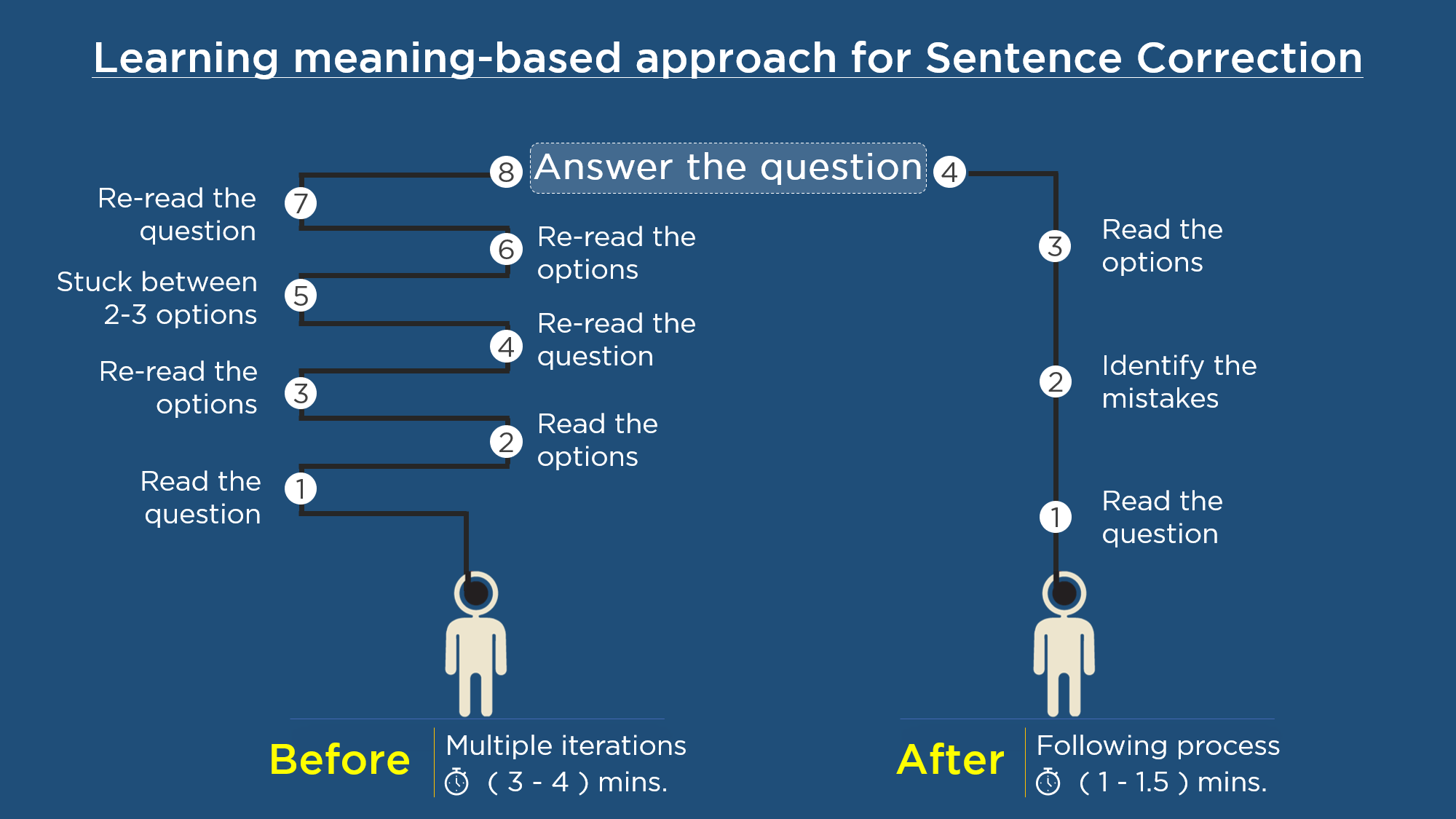
You can practice more GMAT sentence correction questions for free here.






